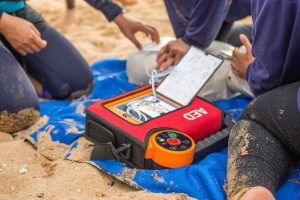 Cardiopulmonary resuscitation (CPR) is the most commonly taught medical technique in the world, but as few as 20 percent of bystanders can adequately perform it in an emergency.
Cardiopulmonary resuscitation (CPR) is the most commonly taught medical technique in the world, but as few as 20 percent of bystanders can adequately perform it in an emergency.
CPR is a simple set of skills, but it can make a huge difference in the outcome for people who experience one of several different types of cardiac arrest. Some recent guidelines have promoted hands-only CPR (CPR without ventilation), which has led to many questions and debates in the diving community. Here’s what you should know as you teach your CPR classes.
You’re a dive professional; at a minimum, you know the basics of CPR and can teach the techniques to your students. Some people spend their entire careers defining and updating standards for CPR and similar emergency skills, and twice every year a group of such people gathers for the International Liaison Committee on Resuscitation (ILCOR) to discuss the latest research on emergency resuscitation techniques and how it should be implemented in training, education, and guidelines. Recent ILCOR meetings have brought significant changes to CPR, increasing focus on compressions and circulation and altering the historical training model.
 If you underwent CPR training before 2015 or so it’s likely you were taught using an ABC (Airway, Breathing, Compressions) model. That model was tried and tested for decades, but recent research has indicated that a CAB (Compressions, Airway, Breathing) model may lead to better outcomes in some circumstances. The new model emphasizes high-quality chest compressions — for an average adult these should be 5 to 6 centimeters (2 to 2.4 inches) in depth and at a rate of 100 to 120 compressions per minute — over airway management and no lapses in compressions longer than eight seconds.
If you underwent CPR training before 2015 or so it’s likely you were taught using an ABC (Airway, Breathing, Compressions) model. That model was tried and tested for decades, but recent research has indicated that a CAB (Compressions, Airway, Breathing) model may lead to better outcomes in some circumstances. The new model emphasizes high-quality chest compressions — for an average adult these should be 5 to 6 centimeters (2 to 2.4 inches) in depth and at a rate of 100 to 120 compressions per minute — over airway management and no lapses in compressions longer than eight seconds.
These guidelines are designed primarily to address the most common and treatable types of sudden cardiac arrest: ventricular fibrillation and ventricular tachycardia. All other types of cardiac arrest (including drowning) are considered special conditions and are covered by additional guidelines. In a sudden cardiac arrest caused by irregular heart rhythms the blood is still sufficiently oxygenated to support life for several minutes, so the priority in these cases is to circulate blood and deliver that oxygen to the brain. Untrained rescuers often spend too much time focusing on ventilations or other tasks, and these guidelines aim to keep that oxygenated blood circulating even if ventilation cannot be performed. Compression-only CPR stems from these recommendations; it is commonly taught outside of the diving industry.
 You may encounter compression-only CPR if you commonly teach non-divers, and you should absolutely be familiar with it, but diving warrants a slightly different approach. Drowning is considered a special case in these guidelines because submerged victims are assumed to be hypoxic (their blood is no longer carrying adequate oxygen to keep the brain and other tissues alive), so CPR standards in diving still emphasize rescue breaths.
You may encounter compression-only CPR if you commonly teach non-divers, and you should absolutely be familiar with it, but diving warrants a slightly different approach. Drowning is considered a special case in these guidelines because submerged victims are assumed to be hypoxic (their blood is no longer carrying adequate oxygen to keep the brain and other tissues alive), so CPR standards in diving still emphasize rescue breaths.
In cases of drowning the heart typically does not stop until the body’s oxygen reserves have been completely depleted. If a victim is hypoxic, chest compressions alone will have little benefit without re-oxygenation of the blood, so ventilation becomes a priority. This is the crux of the hands-only versus traditional CPR debate, and it’s the reason CPR with ventilation is still taught to divers.
For traditional ABC-model CPR, ILCOR special-case guidelines still apply and can be found on the American Heart Association website at CPR.Heart.org. These guidelines also include the recommendation to limit interruptions in compressions to eight seconds or less, making effective and efficient ventilations an important priority, but ultimately they remain fairly similar to prior guidelines.
For more information on CPR or other first aid skills, visit DAN.org.


